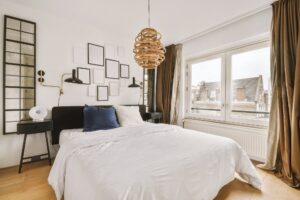The interior design community is seeing a rise in the popularity of Scandinavian design. Scandinavian design has won over the hearts of many designers and homeowners alike with its emphasis on minimalism, functionality, and simplicity. The main components of Scandinavian design will be discussed in this article, along with tips for implementing the look in your own house.
Key Takeaways
- Scandinavian style is a popular interior design trend known for its simplicity, functionality, and minimalism.
- Minimalism is a key aspect of Scandinavian design, with a focus on clean lines, uncluttered spaces, and a lack of unnecessary ornamentation.
- Natural elements and materials, such as wood, stone, and leather, are commonly used in Scandinavian interiors to create a sense of warmth and connection to nature.
- Lighting plays a crucial role in creating a cozy and inviting atmosphere in Scandinavian-style spaces, with a focus on natural light and warm, soft lighting fixtures.
- Neutral colors and pastel hues are a hallmark of Scandinavian decor, with a preference for light, airy tones that create a sense of calm and tranquility.
In the 1950s, the Nordic nations of Denmark, Norway, Sweden, Finland, and Iceland gave rise to Scandinavian design. It was a reaction to the post-war demand for reasonably priced, practical furniture and décor. Nordic designers prioritized producing functional & widely available pieces in addition to beautiful designs. Numerous factors contribute to the appeal of Scandinavian interior design.
Its focus on simplicity and minimalism firstly aligns with the contemporary movement of decluttering and leading a more purposeful life. With its simple lines and uncluttered spaces, Scandinavian design provides a sense of calm and tranquillity in a world full of noise and distractions. Scandinavian design is characterized by minimalism. It is a design philosophy that emphasizes accepting simplicity & removing elements that aren’t necessary. You can frequently find open spaces, simple lines, and a dearth of overbearing ornamentation in Scandinavian interior design.
Scandinavian design fosters a tranquil atmosphere by embracing minimalism, which highlights the space’s usefulness and beauty. This design strategy encourages the use of fewer materials and resources, which also contributes to a more sustainable lifestyle. Utilizing organic materials & elements is one of the hallmarks of Scandinavian design.
Scandinavian interiors frequently use wood, stone, and other natural materials to give the room warmth & texture. Scandinavian design places a lot of emphasis on wood. It’s applied to wall paneling, flooring, and furniture.
The use of wood creates a warm and inviting ambiance while bringing a sense of nature indoors. In order to add a little rustic charm, stone is also frequently used in Scandinavian design, particularly in accent walls and fireplaces. Scandinavian interior design is not an exception when it comes to the importance of lighting. Actually, one of the most important components in establishing a warm and welcoming ambiance in Scandinavian interior design is lighting. Large windows and skylights are common ways that Scandinavian design uses natural light.
As a result, the room feels light and spacious due to the abundance of natural light that enters it. Scandinavian interiors make use of artificial lighting in addition to natural light to create a cozy & welcoming atmosphere. Because it creates a cozier, more intimate atmosphere, soft, diffused lighting is preferable to harsh, bright lighting. Scandinavian design is known for its neutral color palette.
The fundamental colors of Scandinavian interior design are frequently whites, grays, and earthy tones. The simplicity and serenity these muted hues impart let the attention rest on the organic textures and materials used throughout the room. Pastel colors are also frequently used to add a pop of color, even though neutral colors predominate in Scandinavian design. You can find soft blues, pinks, and greens in furniture, accessories, and even textiles.
To an otherwise neutral palette, these pastel colors lend a hint of warmth and playfulness. In Scandinavian design, patterns & textures are used to give a room depth and appeal. Even though Scandinavian design has a generally minimalist look, adding textures and patterns can keep the room from appearing lifeless and dull. The use of organic materials like wool, stone, and wood can introduce textures. These components give the area more tactile and visual interest. Conversely, textiles like carpets, pillows, and drapes can introduce patterns.
Scandinavian design is often associated with geometric patterns, stripes, and floral motifs. Functionality and practicality are valued highly in Scandinavian design. In small spaces, where every available inch must be used effectively, this is especially crucial.
Scandinavian design is characterized by its use of practical furniture and storage options. Multiple uses are frequently considered when designing furniture pieces, as seen in the case of a sofa that doubles as a bed or a coffee table with integrated storage. This makes it possible to have an area that is tidy and uncluttered, which is crucial for establishing a tranquility. A Danish idea that has gained popularity recently is called hygge. It is a sensation of comfort, satisfaction, and wellbeing.
Because the two design philosophies place equal emphasis on coziness and creating a welcoming environment, hygge is frequently connected to Scandinavian style. Concentrate on creating a warm and welcoming atmosphere if you want to create a hygge-inspired space using Scandinavian design. To create a cozy and inviting atmosphere, use soft lighting, luxurious fabrics, & cozy furniture. To add a bit of nature inside, use organic materials like wood & plants.
To truly create a warm & intimate atmosphere, incorporate sentimental pieces and unique finishing touches. The classic appeal of Scandinavian design is well known. It creates a space that is balanced and harmonious by skillfully fusing traditional and modern elements.
Combine modern & traditional elements in your Scandinavian design for a timeless look in your house. For instance, mix and match a traditional patterned rug with sleek and minimalist furniture or a vintage wooden dining table with contemporary chairs. The old and new together provide depth and interest to the room. Creating a Scandinavian aesthetic in your house doesn’t have to be expensive. The following advice can help you incorporate Scandinavian design on a budget:1.
Simplify & declutter: Begin by clearing your area and getting rid of anything superfluous. Adopt a minimalist lifestyle and prioritize excellence above quantity. 2. Shop secondhand: Keep an eye out for antique & used furnishings and décor. Scandinavian furniture at reasonable prices can be found in thrift stores, flea markets, & online marketplaces. 3. Do-it-yourself projects: Use your imagination and give some DIY projects a go.
Repurpose used furniture, create your own textiles & accessories, or paint walls. 4. Concentrate on essential pieces: Make an investment in a few essential pieces, like a sleek sofa or a wooden dining table, that perfectly capture the spirit of Scandinavian style. The focal point of the room and the inspiration for the remaining decor will be provided by these items. 5.
Make use of natural materials: Include organic materials like wool, stone, and wood. These materials offer a hint of Scandinavian charm to your interior design and are frequently available at reasonable costs. To sum up, the simplicity, practicality, and ageless appeal of Scandinavian design have made it increasingly popular in interior design. You may design a beautiful and welcoming Scandinavian-inspired space by combining neutral colors, natural elements, soft lighting, functional furniture, hygge, and textures and patterns. And you can achieve this look without going over budget if you follow a few inexpensive tips.
Accept the Scandinavian style & make your house a chic and comfortable haven.
If you’re looking to create a chic Scandinavian-inspired interior, you’ll definitely want to check out this article on “5 Creative Ideas to Make Your Small Kitchen Feel Bigger.” It offers practical tips and clever design solutions to maximize space and create a stylish yet functional kitchen. From utilizing vertical storage to incorporating light colors and reflective surfaces, these ideas will help you achieve that clean and airy Scandinavian aesthetic. So, if you’re ready to transform your small kitchen into a spacious and inviting space, be sure to click here for some inspiration!
FAQs
What is Scandinavian style?
Scandinavian style is a design movement characterized by simplicity, minimalism, and functionality. It emphasizes clean lines, neutral colors, and natural materials.
What are some key elements of Scandinavian style?
Some key elements of Scandinavian style include light-colored wood, such as birch or pine, white walls, simple furniture with clean lines, and natural textiles like wool and linen.
What are some popular Scandinavian furniture brands?
Some popular Scandinavian furniture brands include IKEA, Muuto, Hay, and Skagerak.
What colors are commonly used in Scandinavian interiors?
Scandinavian interiors typically use a neutral color palette, with white, gray, and beige being the most common colors. Accents of black and muted pastels are also popular.
What types of materials are commonly used in Scandinavian interiors?
Scandinavian interiors often feature natural materials like wood, wool, linen, and leather. Metals like copper and brass are also used as accents.
What are some tips for achieving a Scandinavian look in my home?
To achieve a Scandinavian look in your home, focus on simplicity, functionality, and natural materials. Use a neutral color palette with pops of muted pastels or black accents. Choose furniture with clean lines and natural textures, and incorporate cozy textiles like wool blankets and sheepskin rugs.





